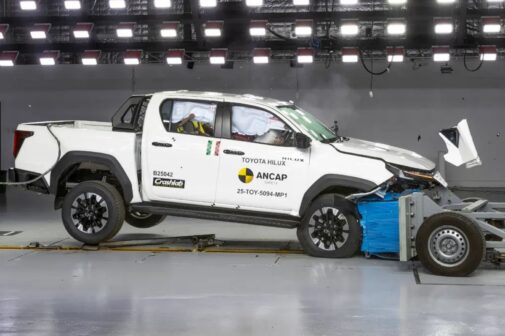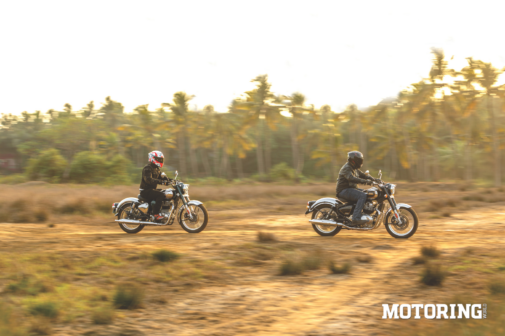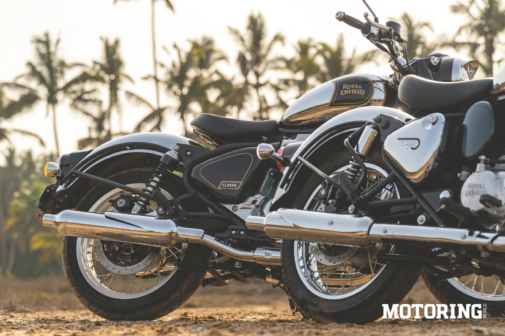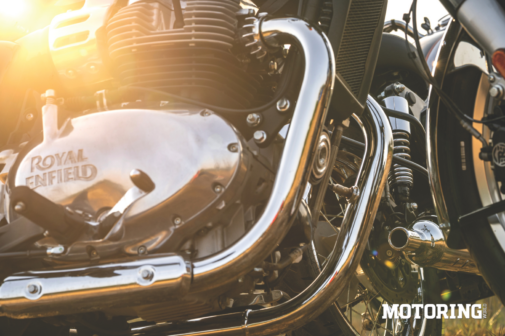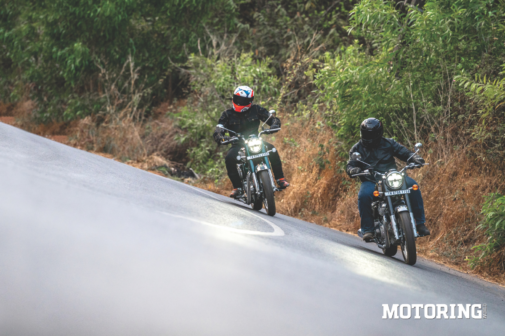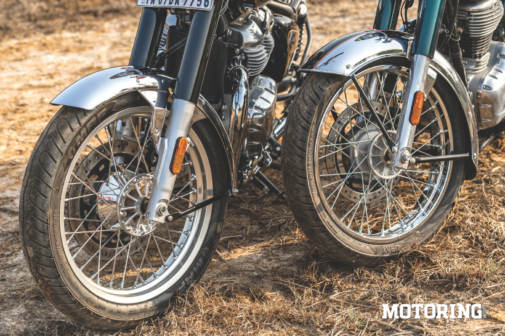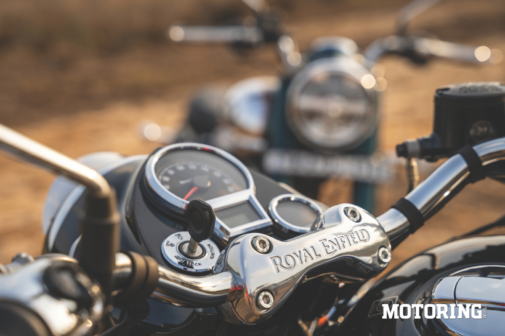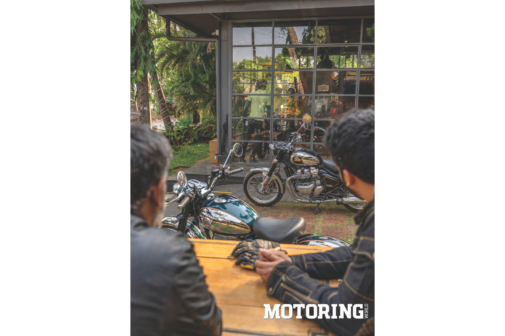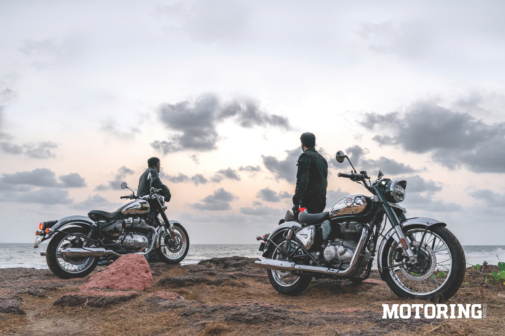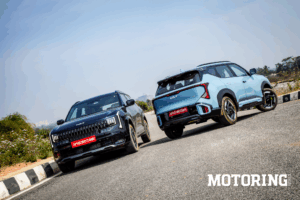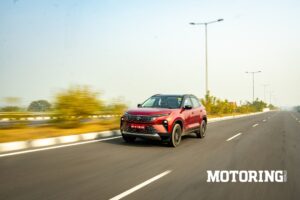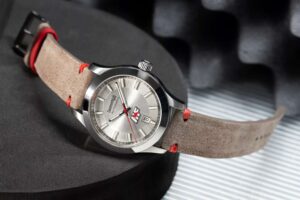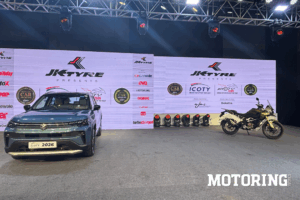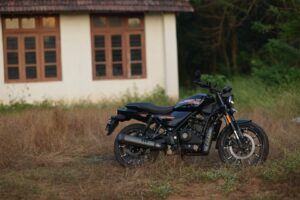When motorcycles come draped in chrome, they become a reflection of life around them. While paint creates a separation between a motorcycle and its backdrop, chrome, with its mirror-like qualities, lets it blend in. This seems funny when you realise ‘chrome’ was derived from the Greek word for colour. What exactly is the colour of chrome, again?
It makes sense why Royal Enfield reserves its heartiest helping of chrome for motorcycles it really wants to blend in with the masses — ones that bear the Classic plaque. We’ve yearned for a larger-engined interpretation of the Classic 350, especially since Royal Enfield whisked away the 500 a few years ago, and now that it’s here, we had to bring it around to meet its namesake, one that scripted the story of Royal Enfield’s revival 16 years ago. Allow me to also pose a question early on — is the bigger, newer Classic really the better motorcycle? Is it also, importantly, the better Classic?
I then promptly reserved these questions to the back of my head as I set off on the Classic 650 on a hot Goan afternoon, with Manaal trailing on the Classic 350. We’d chalked out a brisk 100-km loop starting from the Royal Enfield Garage Cafe, featuring B-roads, NH66 and, hopefully, some traffic. This would see us return in darkness, and in time to crack open a few cold ones — as you do.
Happy to be astride a motorcycle I’d been looking forward to, I settled into an early rhythm on the 650 — much to my surprise — as we navigated past villages transitioning into suburbs. First impressions: the 650 feels large and substantial but not cumbersome. I found its spiritedness odd until some corners came along. Then, I really began to enjoy it. Leaning over as far as I could dare, looking out for a little ‘scritch’ from the footpegs, the Classic 650 felt really alive. I’d imagined a slow amble through North Goa and here I was, being a bit messy; totally out of character for both me and the motorcycle’s alleged personality type. Meanwhile, Manaal did a neat job of keeping up with his 20.2-bhp Classic (also a sizeable 48 kg lighter, not including our own substantial weight difference), while I used most of my 650’s familiar 46.39-bhp output to stay ahead, although still in the early reaches of its 6-speed gearbox. With its eagerness established and duly registered, I calmed down.
There isn’t much by way of mechanical character to the 650’s engine courtesy its 270° crank angle, so going slower also immediately shifts your attention to other things. Like the suspension, for example. I aimed at every pothole in our way and jumped speed breakers at a variety of speeds, but it did nothing alarming to the 650. It’s not plush, though, something I justifiably expected from it. A deal-breaker, though? Absolutely not. It feels noticeably firm at the rear but not in a way that will put you off riding it altogether. See, the Classic 650 amounts to such a tremendous amount of mass, it needs seriously high grade suspension to lend it a magic-carpet ride, something that would invariably result in its 3.49 lakh (ex-showroom, Mumbai) price shooting up. Or, it could just have been lighter in the first place.
That motorcycle already exists, in the form of the Classic 350. A Classic — and I hope we’re on the same page about this — exists purely for its feel, personality and character. It was meant to be nostalgia minus the oil stains on your riding jeans. Over the last decade and a half, the millions who’ve bought a Classic haven’t bought one for its better spec sheet or its ability to solve problems — they’ve done so because it resonates. A Classic is a charming interpretation of a primal ’50s motorcycle — and it’s done to near-perfection. That’s why it works.
As we hit NH66 at dusk, I believed I’d finally be able to shake off the Classic 350 from the 650’s mirrors — literally and figuratively speaking. That part was easy, but now, with no potholes to look out for, I had to confront the real elephant in the room — the engine! Wait, what? It’s an engine we’ve known (and enjoyed) for years, thanks to the Interceptor and the Continental GT, so why aren’t we just glossing over it this time around? Because, to my disappointment, something’s quite noticeably off about it. Having been raised on vastly imperfect motorcycles, I rarely take exception to vibrations, but on the 650 it’s all you notice as you cross 90 kph — coincidentally the exact speed at which the 350 arrives at the threshold of its cruising performance. And it doesn’t go away until after 130 kph, at which point the expected (and reasonable) vibrations of a twin-cylinder kick in anyway. It could be that our test bike is an anomaly, but I also can’t confirm it for now.
Sheepishly, then, to really enjoy a breezy highway ride on the Classic 650, I had to slow down to Classic 350 speeds. Manaal, as you would expect, was right there, looking on as confusedly as I was from behind the 650’s enormous and beautiful casquette. Still unconvinced, I gave the 650 one final push — into speeds that are, frankly, just unrealistic for a country such as ours — before making a U-turn and pulling over to take a breather by the Armco barrier. In the interest of fairness, I said very little to Manaal about the ride so far before we swapped bikes.
On the Classic 350, I felt instantly at home, although it did feel noticeably smaller. Familiarity has done little to take away how special it feels, though. There’s a nice pulse that emerges from its 349cc single cylinder engine and it settles very quickly into its highway cruising speed, tapering off only past 90 kph, with strain setting in past 100. That’s acceptable for a motorcycle you’re meant to see the world on at 80 kph (60, if you’re a romantic) anyway. There’s not a buzz in sight, and while it lacks the real estate of the Classic 650, it still feels roomy and plush.
By the time we took the off ramp back into the B-roads, this time through Guirim, I was in my well-rehearsed rhythm with the Classic 350, a motorcycle that started a now-mandatory Sunday riding routine for Kartik and I when it came about in 2021. It’s not a particularly involving motorcycle — it’s fun and sensory, but not overwhelmingly so — but, by its very nature, it’s the kind of bike you’d really enjoy exploring, say, the rural world on. I love the sensations of riding a long-stroke motorcycle and, even without a pushrod, the Classic feels very much like the motorcycles it’s meant to emulate. It’s easy, gentle and full of character, muted in a well-meaning way. At Rs. 2.32 lakh (ex-showroom, Mumbai), it’s also over a lakh cheaper, I should add.
It leans over in a fairly nondescript fashion, too, with its soft rear springs making it a tad wallowy but not in a way you would really mind. The brakes are good, the tyres feel adequate and, on the whole, the 350 feels perfectly well-suited to touring, with the exception of not having much in reserve for flat-out highway riding, of course. Oddly, it’s the Classic 650 that suffers on one of these counts, being heavy and also awfully under-tyred (at least at the front, and not just visually) which results in somewhat unstable heavy braking performance. So much, in fact, that I managed to lock the front wheel under really hard braking at least a couple of times. Hmpf!
Okay, it’s time to make a confession. I have quite publicly declared my love for the Classic 650, much before it even existed. The idea of a Classic with a larger, torquier engine and twin exhausts seemed like the perfect idea of a Sunday morning motorcycle for someone looking for that old British-bike feel and new-bike reliability. My liberal imagination translated this as, essentially, a meatier Classic based on its own cradle frame rather than the Interceptor’s. It could have a small tank, switchgear as optional extras and come with deflated tyres, but I wanted it to be dense, with its engine playing the unapologetically dominant hero. For that motorcycle, I would unquestioningly pay its asking price for its character alone. I just wanted Royal Enfield to make one as soon as possible. To my delight, it did.
However, Royal Enfield has interpreted the Classic 650 rather differently. When the time came to build one, it took its biggest frame off the rack — the Super Meteor 650’s — which was, to put it politely, a tough starting point. Motorcycles built on that frame (SM650, Shotgun) are invariably long and low, and a motorcycle with a wheelbase 85 mm longer than a Classic 350 was never going to match its profile. It’s also needlessly heavier (30 kg more than an Interceptor? Really?!) and that isn’t down to its larger fuel tank which, at 14.8 litres, still translates to more or less the same kind of distance between fuel stops as the 350, with its 13-litre tank.
When we parked our bikes at the Garage Cafe later that evening, I felt I was being too objective. For one, perhaps I was obsessing unnecessarily over a nameplate, however important it may have been to Royal Enfield’s fortunes. What if, for instance, the Classic 650 had preceded the 350 by the same margin? Would the latter’s shift in approach have deemed it the less pure of the Classics, then? Perhaps. Context comes with its disadvantages, no? Would the 350 still have come across as the better motorcycle, though? I think so.
There’s a fundamental reason to why we’ve arrived at this Classic conundrum. The first Classic, you see, was born out of survival instinct. Back in 2009, Royal Enfield was on the verge of extinction and, therefore, to have read the room incorrectly would have meant disaster. To Royal Enfield’s credit, it read a room that didn’t exist at all, unknowingly emerging as the pioneer of the modern-retro class of motorcycles. The Classic that followed did one better, coming out of a well-meaning quest for perfection. No such compulsion prevailed for the newest of the Classics, though. It might as well have been called a ‘Classic’ variant of the Super Meteor and absolved itself of the responsibility of legacy. Gen-Z, much?
There’s a bright side to this, too. I’ll simply continue to wait for the motorcycle I’d manifested years ago — gosh, I enjoy waiting for great bikes to happen! Meanwhile, it might serve Royal Enfield well to reflect and do right by a name it owes so much to. Chrome is a great place to start looking, isn’t it?









